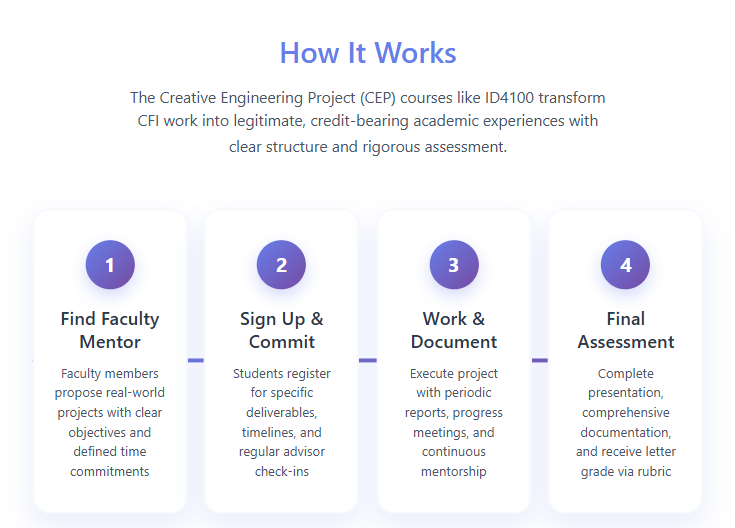Picture this: A student spends hours in the CFI lab, building a prototype that could solve water scarcity in rural areas. Meanwhile, their friend is cramming for another theoretical exam. Who’s doing “real” academic work? The answer might surprise you.
The Great Academic Debate
For years, CFI projects existed in an academic gray zone. Students loved the hands-on experience, but not only did the skeptics question whether tinkering with gadgets counted as serious study, but they also lost out on the enormous time they put into such projects because of their passion. That changed dramatically in 2017 when something revolutionary was introduced to encourage students to get involved in such CFI work - the Creative Engineering Project (CEP) courses, like ID4100.
There’s not just a single course — there are now multiple options, including ID3100 and ID4100, alongside the Undergraduate Research Credits (UGRC). Together, these opportunities allow students to earn up to the equivalent of one course per semester, across four semesters!
Suddenly, CFI work wasn’t just a hobby—it became legitimate, credit-bearing academic work.
Breaking Down the Credit System
Here’s how students actually earn credits through CFI work:
The Framework is Simple but Rigorous: Faculty members propose real-world projects (most of them being CFI projects) with clear objectives and time commitments. Students sign up, work under mentorship, and get graded just like any other course. The catch? Projects must integrate material from the first six semesters, ensuring academic depth isn’t sacrificed for creativity.
Assessment That Matters: Students submit periodic reports, participate in progress meetings with advisors, and produce comprehensive final documentation. Their work gets archived at cfi.iitm.ac.in, creating a searchable knowledge base for future students. Letter grades are assigned using predetermined rubrics—no different from traditional courses.
Team or Solo? Your Choice: Whether working individually or in teams, each student’s contribution is clearly documented and individually assessed. This mirrors real engineering practice where collaboration is key, but accountability remains personal.
Why This Actually Strengthens Academic Work
At CFI, theory doesn’t stay locked in textbooks—it comes alive through hands-on projects that push students to apply what they’ve learned in class to real-world challenges.
That fluid mechanics course? Suddenly, it’s essential when you’re redesigning a water pump for better efficiency.
Thermodynamics? No longer just abstract equations, but the key to perfecting your solar cooker.
Beyond technical knowledge, CFI projects cultivate skills traditional courses often miss: managing timelines, communicating with clients, and transforming ambitious ideas into working prototypes. And it doesn’t stop there—every project demands detailed documentation, reports, and presentations, sharpening students’ technical writing and presentation abilities. Many even discover that explaining their innovations helps them grasp the underlying concepts more deeply, turning them into not just better engineers, but better thinkers.
The “Distraction” Myth Debunked
Critics worry CFI work pulls students away from “serious” study. The structured CEP framework actually aids the CFI lovers to be well-rounded by
- Clear Time Boundaries: Defined project scopes and timelines help students channel their efforts efficiently and achieve meaningful outcomes within a set period.
- Faculty Oversight: Regular mentor meetings provide guidance and keep students aligned with both their project goals and academic development.
- Integration Requirements: Projects are designed to connect with curriculum content, deepening classroom learning and allowing students to apply concepts in practical, hands-on ways.
Real Stories, Real Impact
Students working on CFI projects aren’t just building gadgets—they’re solving problems. One team might develop assistive technology for individuals with different abilities, while another creates sustainable energy solutions. These aren’t academic exercises; they’re potential patents, startup ideas, and portfolio pieces that impress employers.
Future-Proofing Engineering Education
The integration of CFI work into formal academics reflects a broader shift in engineering education. Industry demands graduates who can innovate, not just calculate. Companies want problem-solvers who understand both theory and practice.
CFI projects through CEP courses provide exactly this balance. Students graduate with traditional technical knowledge plus hands-on experience building real solutions.
The Verdict
CFI work isn’t a distraction from academic excellence. It is academic excellence - enabled and displayed. The formal framework ensures rigor while encouraging creativity. Students earn legitimate credits while developing skills that textbooks can’t teach. The question isn’t whether CFI work belongs in academia. The lab and the classroom aren’t competitors - they’re partners in transforming the next generation into competent engineers.
